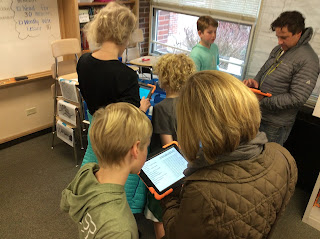We couldn't have done the zoos without our parents (that's you!). When we needed chaperones for a trip to the zoo in mid-December, you supported us. When we reached out to you to ask for assistance at home for our students who were struggling to finish research, you supported us. When we needed all hands on deck for the zoo build days, you supported us. When we opened our doors for zoo presentations and visitors, you supported us. And these are just the supports that were visible! We know how many hours of supporting your students undoubtedly went on "behind the scenes" in order to pull off a project like this, and we thank you!
We couldn't have done the zoos without the students we have this year. Our students embarked on this journey with us and showed complete faith at every turn. We asked them to complete challenging tasks: the math was difficult, the notetaking was tedious, the writing required precision. They stuck with us every step of the way. These kids showed a lot of grit. They put in extra time and extra effort at every turn. Students came in early for everything from writing help to hot-glue assistance and everything in between. Many groups set up times to meet in the art room in order to add extensive details to their zoos. We know how many extra hours went into making these zoos a reality, and we can't thank our students enough!
Finally, we couldn't have done the zoos without the awesome support systems we have at Skokie. Mr. Weir and his tech team in the Marker's Lab were a critical part of this journey. We learned about effective Internet searching, Lego 3-D building and Adobe Spark Page from him. The tech team was always available to help troubleshoot. It's also amazing to work in a building where your colleagues and administrators support your efforts so much. The number of teachers who stopped by to lend a helping hand (Mr. Greenman was in almost daily once the building started) and showed their support by bringing their classes to see the finished products was inspiring. We cannot thank our colleagues and administration enough for allowing this thought to grow wings and fly!
The final projects were nothing short of stunning! We thank you for taking this journey with us. We are so proud of the accomplishments of the students!
Social Studies Unit 3: The Characteristics of Civilizations
Students began their third unit in social studies: The Characteristics of Civilizations. We began this unit with a reading about ancient Sumer. Students took notes to help them remember each characteristic of civilization. This week students completed a scavenger hunt to review the characteristics and begin writing research questions that will be revised and used to help guide them through the unit.
 |
| Students used their notes to help them complete a scavenger hunt and write research questions. |
Over the next weeks in the classroom, students will begin researching the ancient civilizations looking for evidence of these seven characteristics:
- Stable Food Supply
- Government
- Religion
- The Arts
- Writing
- Technology
- Social Structure
We'll also ask them to look for evidence of these seven characteristics in the world around them. Through multiple engaging tasks, students will see how these characteristics are what make our civilizations unique and unite us. It's an exciting unit!
Media Recommendation: Planet Earth and Planet Earth 2
I know I usually reserve this space to recommend a book or two, but I have to take a moment at the end of our zoo projects to highlight the Planet Earth series. These documentaries are true feats of cinematography! Many of the moments they've captured have never before been seen. The landscapes are stunning, and the animals are the stars. We've had a chance to watch clips at school recently as we've put our rooms back together, and the kids' wonder at the natural world has truly been sparked!




